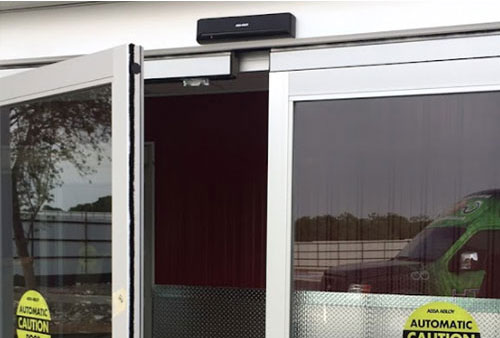Entry sensors detect when a door or window opens. Most use two pieces: a sensor and a magnet. The sensor mounts to the frame, and the magnet attaches to the moving part of the door or window. The magnet keeps the circuit closed when the door or window is closed.
If the door or window opens, the magnet moves away from the sensor. This break in the circuit sends a signal to the alarm control panel, which then triggers an alert or alarm. Entry sensors work well for both residential and commercial security systems. They are easy to maintain and last for years with proper installation.
Types of Entry Sensors
Entry sensors vary in design and function. The most common types include contact sensors, recessed sensors, and surface-mounted sensors.
- Contact sensors mount on the surface of doors or windows and are visible when installed.
- Recessed sensors are installed inside the door or window frame for a hidden appearance.
- Heavy-duty sensors handle commercial or industrial environments where doors are larger and open more often.
Each type connects to the alarm system through hardwiring or wireless communication. Wireless sensors work well in existing buildings, while wired sensors are common in new construction.
How Entry Sensors Connect to Your System
Most entry sensors pair with a control panel through a wired or wireless link. The control panel processes the signal and decides what to do next. The system can trigger a siren, send a push notification, or alert a monitoring center if the system is armed.
Some sensors connect to smart home platforms. This lets you receive phone alerts automatically when a door opens or lock a smart deadbolt. Many commercial clients also link entry sensors to access control systems to track when staff members enter or leave.
Where to Place Entry Sensors in a Home
Entry sensors work best when they cover all accessible openings. The front and back doors are the first priority. Place sensors at the top of the door frame where they align with the door edge. This keeps them out of reach of children and reduces the risk of tampering.
Windows on the ground floor, especially those not visible from the street, should have sensors. Sliding glass doors also need sensors because they are common entry points during break-ins. Garages with interior doors leading into the home should have sensors on both the exterior and interior doors.
Where to Place Entry Sensors in a Business
Businesses often need more sensors than homes. Entry points can include glass storefront doors, loading dock doors, and interior office doors. Place sensors on all public entrances and any employee entrances not covered by access control systems.
Sensitive areas like inventory rooms, IT server rooms, or file storage should also have sensors. These locations often require extra logging or alerts for security audits. In larger facilities, group sensors by zones so the system can identify which door triggered the alarm.
Placement Tips for Better Performance
Entry sensors work best when they are aligned correctly and kept free of damage. Here are key tips:
- Mount the sensor and magnet within the recommended gap distance from the manufacturer
- Place sensors high enough to prevent tampering
- Avoid placing sensors where doors or windows may slam and cause damage
- Test sensors after installation to confirm reliable alerts
Consistent testing helps detect problems early, such as a weak wireless connection or low battery. Many security systems can send alerts when a sensor battery runs low or loses contact with the control panel.
How La Jolla Security Systems Can Help
La Jolla Security Systems installs entry sensors for homes, offices, and commercial properties across San Diego County. We select the right type of sensor for each opening, position it for the best detection, and connect it to your alarm system. Our team also tests and configures alerts so you know exactly when a door or window opens.
Since 2009, we have worked with properties ranging from small apartments to multi-building commercial sites. Whether you need a few sensors for a condo or dozens for a business, we provide reliable installation and support. Contact us today to schedule an on-site evaluation and learn how to secure every entry point on your property.
